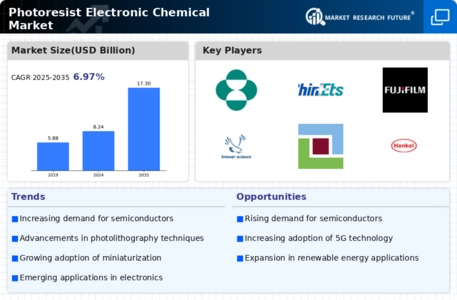Rising Demand for Semiconductors
The Photoresist Electronic Chemical Market is experiencing a notable surge in demand for semiconductors, driven by the proliferation of electronic devices and the Internet of Things. As industries increasingly rely on advanced semiconductor technologies, the need for high-quality photoresists becomes paramount. In 2025, the semiconductor market is projected to reach approximately 600 billion USD, indicating a robust growth trajectory. This growth is likely to propel the demand for photoresist chemicals, which are essential in the photolithography process of semiconductor manufacturing. Consequently, the Photoresist Electronic Chemical Market is poised to benefit from this expanding semiconductor landscape, as manufacturers seek innovative solutions to meet the evolving requirements of the electronics sector.
Growing Demand for Consumer Electronics
The Photoresist Electronic Chemical Market is significantly influenced by the growing demand for consumer electronics. With the increasing adoption of smartphones, tablets, and wearable devices, the need for advanced semiconductor technologies is escalating. In 2025, the consumer electronics market is projected to surpass 1 trillion USD, creating a substantial opportunity for photoresist manufacturers. This demand is likely to drive the production of high-quality photoresists that are essential for the fabrication of intricate electronic components. As consumer preferences evolve towards more sophisticated devices, the Photoresist Electronic Chemical Market is expected to adapt, ensuring that manufacturers can meet the rising expectations of consumers.
Advancements in Photolithography Techniques
Innovations in photolithography techniques are significantly influencing the Photoresist Electronic Chemical Market. The introduction of extreme ultraviolet (EUV) lithography and other advanced methods is enhancing the precision and efficiency of semiconductor fabrication. These advancements necessitate the development of specialized photoresist materials that can withstand the rigorous demands of modern manufacturing processes. As the industry moves towards smaller node sizes, the need for high-performance photoresists becomes increasingly critical. The market for EUV lithography is expected to grow substantially, with estimates suggesting a value of over 10 billion USD by 2026. This trend indicates a strong correlation between technological advancements in photolithography and the growth of the Photoresist Electronic Chemical Market.
Increased Investment in Research and Development
Investment in research and development (R&D) within the Photoresist Electronic Chemical Market is on the rise, as companies strive to innovate and enhance their product offerings. This focus on R&D is driven by the need for advanced materials that can meet the stringent requirements of modern semiconductor manufacturing. In 2025, it is anticipated that R&D expenditures in the chemical sector will exceed 20 billion USD, reflecting a commitment to developing next-generation photoresists. Such investments are likely to yield breakthroughs in performance, enabling manufacturers to produce smaller, more efficient electronic components. As a result, the Photoresist Electronic Chemical Market stands to gain from these advancements, fostering a competitive landscape that prioritizes innovation.
Regulatory Compliance and Environmental Standards
The Photoresist Electronic Chemical Market is also shaped by increasing regulatory compliance and environmental standards. As governments and organizations emphasize sustainability, manufacturers are compelled to develop eco-friendly photoresist solutions that minimize environmental impact. This shift towards greener alternatives is likely to drive innovation within the industry, as companies seek to align their products with regulatory requirements. In 2025, it is projected that the market for sustainable chemicals will reach approximately 300 billion USD, indicating a growing trend towards environmentally responsible practices. Consequently, the Photoresist Electronic Chemical Market may experience a transformation as it adapts to these evolving standards, fostering a more sustainable future.






















Leave a Comment